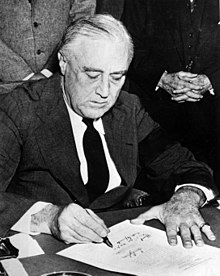United States declaration of war on Japan
Pub. L. 77–328 | |
| Statutes at Large | 55 Stat. 795 |
|---|---|
| Legislative history | |
| |

On December 8, 1941, at 12:30 PM ET the
Background
The
The
Vote and Presidential signature
President Roosevelt formally requested the declaration in his Day of Infamy Speech, addressed to a joint session of Congress and the nation at 12:30 p.m. on December 8.[11] Roosevelt's speech described the attack on Pearl Harbor, describing the event as a deliberately planned attack by Japan on the United States. The speech described the loss of American naval and military forces as well as the loss of American lives. Further, Roosevelt cited other attacks that took place by Japan during the attack on Pearl Harbor, including attacks on Malaya, Hong Kong, and Guam.[12] The speech was met with widespread support. The declaration was quickly brought to a vote; it passed the Senate, and then passed the House at 1:10 p.m.[11] The vote was 82–0 in the Senate and 388–1 in the House. Roosevelt signed the declaration at 4:10 p.m the same day.[11]
The

Text of the declaration
JOINT RESOLUTION Declaring that a state of war exists between the Imperial Government of Japan and the Government and the people of the United States and making provisions to prosecute the same.
Whereas the Imperial Government of Japan has committed unprovoked acts of war against the Government and the people of the United States of America:
Therefore be it Resolved by the Senate and House of Representatives of the United States of America in Congress assembled, That the state of war between the United States and the Imperial Government of Japan which has thus been thrust upon the United States is hereby formally declared; and the President is hereby authorized and directed to employ the entire naval and military forces of the United States and the resources of the Government to carry on war against the Imperial Government of Japan; and, to bring the conflict to a successful termination, all the resources of the country are hereby pledged by the Congress of the United States.[16]
See also
- Arcadia Conference
- Declaration of war by the United States
- Declarations of war during World War II
- Diplomatic history of World War II
- Japanese declaration of war on the United States and the British Empire
- Kellogg–Briand Pact
- United Kingdom declaration of war on Japan
- United States declaration of war on Germany (1941)
- United States declaration of war on Italy
- 12 Days Leading Up to Pearl Harbor[17][18]
- World War 1[19][20]
References
- ^ "Japan declares war, 1941 | Gilder Lehrman Institute of American History". www.gilderlehrman.org. Retrieved 2023-11-13.
- ^ "Pearl Harbor attack: Facts & Related Content". Britannica.
- ISBN 978-0-415-94029-0, archivedfrom the original on 2015-09-06, retrieved 2016-06-04
- ^ Calvocoressi, Peter; Wint, Guy & Pritchard, John (1999) The Penguin History of the Second World War, London: Penguin. p.952
- JSTOR 3640669. Retrieved 2023-11-13.
- ^ "Japan Declares War, 1941". History Resources.
- ^ Prange, Gordon W. (1982) At Dawn We Slept: The Untold Story of Pearl Harbor, Dillon. pp.424, 475, 493-94
- ^ "Japan declares war, 1941". History Resources.
- ^ Staff (December 15, 1941) "The U.S. At War, The Last Stage" Time
- JSTOR 1006337.
- ^ ISSN 0362-4331. Archived from the originalon 2018-02-09. Retrieved January 16, 2012.
- ^ Roosevelt, Franklin D. "Speech by Franklin D. Roosevelt, New York (Transcript)". Library of Congress.
- ^ "Jeannette Rankin: Suffragist, Congresswoman, Pacifist". Montana Women's History. April 1, 2014. Archived from the original on 2020-10-23.
- ^ Luckowski, Jean; Lopach, James (ndg). "A Chronology and Primary Sources for Teaching about Jeannette Rankin" (PDF). Montana.gov. Archived from the original (PDF) on 2020-07-23.
- ^ "Miss Rankin Is Lone Dissenter in War Vote". The Milwaukee Sentinel. December 9, 1941. Archived from the original on 12 May 2016. Retrieved 20 December 2018.
- ^ "Declaration of War with Japan" Retrieved 2010-15-7
- ISBN 978-1-4767-7648-4.
- ISBN 978-1-4767-7648-4.
- ISBN 978-1-108-49619-3.
- ISBN 978-1-108-49619-3.
